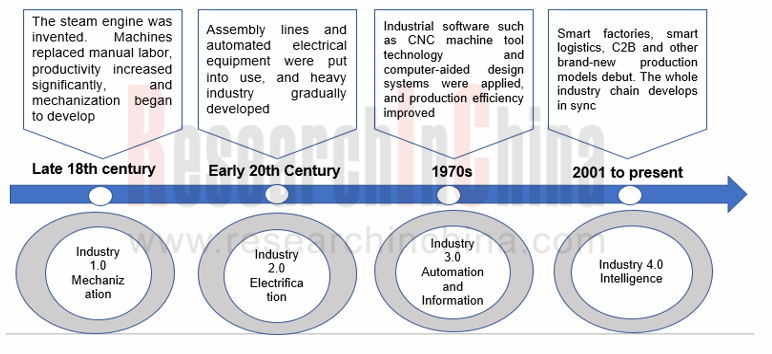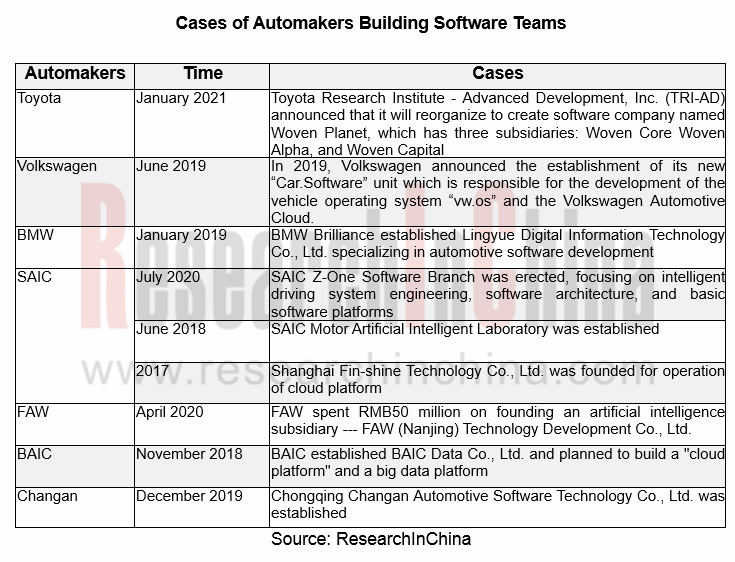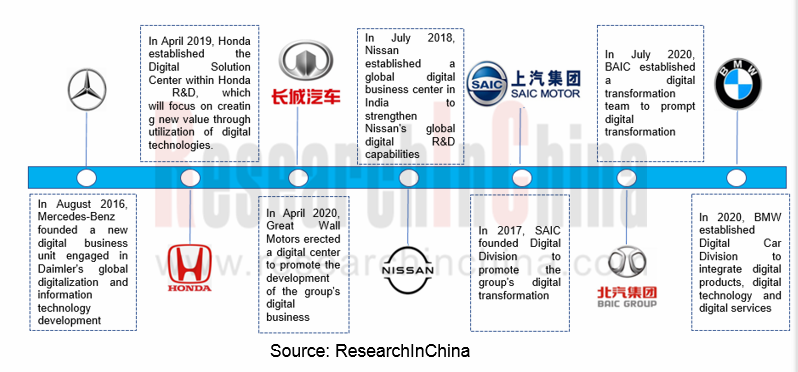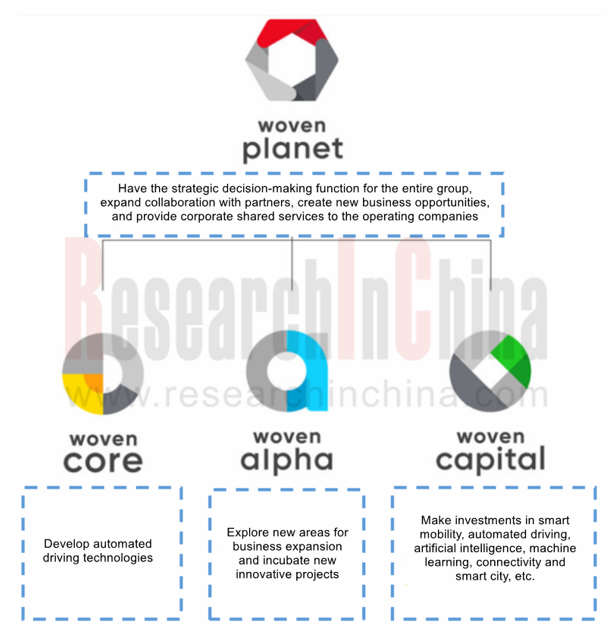Research on digital transformation of automakers: Tesla is still the best reference
Digital transformation means that enterprises make full use of digital technologies (such as big data, cloud computing, artificial intelligence, etc.) in R&D, production, marketing and services to promote the transformation of business models, organizational structures, etc., so that concepts like intelligent manufacturing are derived.
Digital transformation in the automotive industry includes R&D and production digitalization, marketing service digitalization, product digitalization, and management digitalization.

In essence, digitization actually maps and orderly manages the real world (such as cars, roads, car owners, etc.) in the virtual world. The real world is transformed into various information systems through data collection from automobile production, R&D, marketing, services and management. Via the integration of information and data, big data and artificial intelligence technology which optimizes the processing of the virtual world, the process and management of the real world are optimized as well.
During the “Industry 3.0” era (automation and information age, approximately from 1980 to 2010), production information systems, R&D information systems, sales information systems, user and service information systems, etc. were formed, but these information systems were basically isolated then. Due to the low frequency of information collection, a lot of information still lagged.
With the substantial improvement in chip computing power and storage capacity, the automotive industry has entered the era of Industry 4.0 (intelligence) which will connect information systems in all business links. At the same time, the frequency and precision of information collection will be greatly improved, and some fields may even see digital twin (that is, the virtual world by digital mapping is highly consistent with the real world).
Tesla achieves the highest degree of intelligence among all automakers, and has basically connected the information systems and data of all business links. Tesla not only conducts self-research on electrification, connectivity and intelligence of cars, but also tries its best to develop software systems in the entire life cycle of cars.
Software-driven is the source of Tesla’s subversion of the entire automotive industry. Its self-developed software system named Warp supports its direct sales business in the United States and adapts to growth in China and other markets around the world. Warp is a combination of e-commerce and back-end management software and completely customized to support Tesla's counter-approach to selling and servicing cars. The automaker uses its Warp-powered e-commerce website and its own showrooms, not dealerships, to sell cars. Warp also handles all the back office functions for Tesla such as order processing, supply chain management, manufacturing workflow management, financial accounting and lead management.
China's emerging automaker NIO adopts a sales model similar to Tesla’s. No matter online or offline, NIO prefers self-operation and self-establishment. It basically relies on online channels to sell products, while displays the brand and offers user experience services offline. NIO's experiential digital marketing is widely praised. In terms of experience marketing, NIO starts from eight aspects: content experience, social experience, lifestyle experience, car purchase experience, driving experience, service experience, energy supplement experience, and battery swap experience.

Take the social experience as an example: users can set up groups in the NIO App. In other words, once a user becomes a car owner, a dedicated car owner service group of 13 people will be formed. In the service group, there are sales partners, service specialists, power-on specialists, as well as various technical specialists and city general managers. When users have any problems in the process of using cars, they can inquire in the group, and someone will respond to and solve problems immediately.
The traditional automakers BMW and Mercedes-Benz have developed APPs which pay attention to functions and require registration. They only provide services for existing car owners, so they are unattractive to potential car owners. The limited traffic cannot support sales volume conversion.
As the emerging automakers represented by Tesla have been digitally operated from the beginning, they are sought after by consumers and recognized by the market. The emergence of new forces has posed tremendous pressure on traditional automakers who thus have formulated digital strategies one after another to boost digital transformation.
At present, automakers mainly deploy digital transformation in five aspects:
First, they establish software companies or R&D divisions as well as build software teams through self-construction or cooperation.

Second, automakers set up digital centers internally to coordinate the digital transformation of the entire groups and promote the implementation of overall digital strategy.

Third, automakers can reduce costs and improve competitiveness by allying with other automakers.
Fourth, automakers prompt digital transformation through cooperation with technology companies (such as Baidu, Alibaba, Tencent, Huawei, etc.).
Fifth, automakers create an online & offline user-centric digital marketing model.
GM’s 4S stores have evolved into a "7S modular dealer service system" consisting of New Car Sale, After-Sales Services, Spare Parts, Information Survey, Pre-owned Car Services, Sharing and Financial Support.
Xpeng's "2S+2S" marketing model disassembles "4S" into two parts: online (marketing and parts available on Tmall) and offline (after-sales services and information feedback). Through the dual-channel linkage of "the Tmall flagship store + offline stores", Xpeng connects both online and offline fields, which not only greatly reduces costs, but also brings consumers with new experience.
This report analyzes 21 OEMs’ strategies and specific measures for transformation. Conventional automakers like Toyota and Changan Automobile have made successes in digital transformation as well, in addition to emerging carmakers.
Toyota Digital Transformation focuses on five aspects: first, adjusting organizational structure, with high priority on restructuring of TRI-AD, Toyota’s advanced software company and segmenting its business into “R&D of Automated Driving Technologies”, “Incubation of Innovative Projects” and “Investment in Emerging Areas”; second, launching the Mobility Services Platform (MSPF) for an upgrade to the next-generation mobility services; third, building a cloud service platform for better business and operation models; fourth, creating Toyota New Global Architecture (TNGA) to reform R&D and production links; fifth, developing digital products, with deployments in autonomous driving, HD map, chip, HMI, etc.

Changan Automobile takes software as its corporate strategy, setting up a software center to enhance its digital transformation. For R&D and production, the automaker builds a R&D cloud platform for advancing construction of smart cities; for marketing, it creates an integrated marketing cloud platform and self-establishes an ecommerce platform; for product digitization, it makes deployments in areas from cloud platform and intelligence to telematics by way of independent construction and cooperation.
Despite great efforts on digital transformation, quite a few automakers still face some challenges, such as:
 Underpowered transformation, disputed transformation model, and some departments’ reluctance to transform;
Underpowered transformation, disputed transformation model, and some departments’ reluctance to transform;
 Poor ability to attract customers online in digital marketing, and lower-than-expected return on offline high investment;
Poor ability to attract customers online in digital marketing, and lower-than-expected return on offline high investment;
 Under-investment in digital transformation, which blames for conventional businesses;
Under-investment in digital transformation, which blames for conventional businesses;
 Lack of software teams and user operation experience.
Lack of software teams and user operation experience.
China Automotive Lighting and Ambient Lighting System Research Report, 2025
Automotive Lighting System Research: In 2025H1, Autonomous Driving System (ADS) Marker Lamps Saw an 11-Fold Year-on-Year Growth and the Installation Rate of Automotive LED Lighting Approached 90...
Ecological Domain and Automotive Hardware Expansion Research Report, 2025
ResearchInChina has released the Ecological Domain and Automotive Hardware Expansion Research Report, 2025, which delves into the application of various automotive extended hardware, supplier ecologic...
Automotive Seating Innovation Technology Trend Research Report, 2025
Automotive Seating Research: With Popularization of Comfort Functions, How to Properly "Stack Functions" for Seating?
This report studies the status quo of seating technologies and functions in aspe...
Research Report on Chinese Suppliers’ Overseas Layout of Intelligent Driving, 2025
Research on Overseas Layout of Intelligent Driving: There Are Multiple Challenges in Overseas Layout, and Light-Asset Cooperation with Foreign Suppliers Emerges as the Optimal Solution at Present
20...
High-Voltage Power Supply in New Energy Vehicle (BMS, BDU, Relay, Integrated Battery Box) Research Report, 2025
The high-voltage power supply system is a core component of new energy vehicles. The battery pack serves as the central energy source, with the capacity of power battery affecting the vehicle's range,...
Automotive Radio Frequency System-on-Chip (RF SoC) and Module Research Report, 2025
Automotive RF SoC Research: The Pace of Introducing "Nerve Endings" such as UWB, NTN Satellite Communication, NearLink, and WIFI into Intelligent Vehicles Quickens
RF SoC (Radio Frequency Syst...
Automotive Power Management ICs and Signal Chain Chips Industry Research Report, 2025
Analog chips are used to process continuous analog signals from the natural world, such as light, sound, electricity/magnetism, position/speed/acceleration, and temperature. They are mainly composed o...
Global and China Electronic Rearview Mirror Industry Report, 2025
Based on the installation location, electronic rearview mirrors can be divided into electronic interior rearview mirrors (i.e., streaming media rearview mirrors) and electronic exterior rearview mirro...
Intelligent Cockpit Tier 1 Supplier Research Report, 2025 (Chinese Companies)
Intelligent Cockpit Tier1 Suppliers Research: Emerging AI Cockpit Products Fuel Layout of Full-Scenario Cockpit Ecosystem
This report mainly analyzes the current layout, innovative products, and deve...
Next-generation Central and Zonal Communication Network Topology and Chip Industry Research Report, 2025
The automotive E/E architecture is evolving towards a "central computing + zonal control" architecture, where the central computing platform is responsible for high-computing-power tasks, and zonal co...
Vehicle-road-cloud Integration and C-V2X Industry Research Report, 2025
Vehicle-side C-V2X Application Scenarios: Transition from R16 to R17, Providing a Communication Base for High-level Autonomous Driving, with the C-V2X On-board Explosion Period Approaching
In 2024, t...
Intelligent Cockpit Patent Analysis Report, 2025
Patent Trend: Three Major Directions of Intelligent Cockpits in 2025
This report explores the development trends of cutting-edge intelligent cockpits from the perspective of patents. The research sco...
Smart Car Information Security (Cybersecurity and Data Security) Research Report, 2025
Research on Automotive Information Security: AI Fusion Intelligent Protection and Ecological Collaboration Ensure Cybersecurity and Data Security
At present, what are the security risks faced by inte...
New Energy Vehicle 800-1000V High-Voltage Architecture and Supply Chain Research Report, 2025
Research on 800-1000V Architecture: to be installed in over 7 million vehicles in 2030, marking the arrival of the era of full-domain high voltage and megawatt supercharging.
In 2025, the 800-1000V h...
Foreign Tier 1 ADAS Suppliers Industry Research Report 2025
Research on Overseas Tier 1 ADAS Suppliers: Three Paths for Foreign Enterprises to Transfer to NOA
Foreign Tier 1 ADAS suppliers are obviously lagging behind in the field of NOA.
In 2024, Aptiv (2.6...
VLA Large Model Applications in Automotive and Robotics Research Report, 2025
ResearchInChina releases "VLA Large Model Applications in Automotive and Robotics Research Report, 2025": The report summarizes and analyzes the technical origin, development stages, application cases...
OEMs’ Next-generation In-vehicle Infotainment (IVI) System Trends Report, 2025
ResearchInChina releases the "OEMs’ Next-generation In-vehicle Infotainment (IVI) System Trends Report, 2025", which sorts out iterative development context of mainstream automakers in terms of infota...
Autonomous Driving SoC Research Report, 2025
High-level intelligent driving penetration continues to increase, with large-scale upgrading of intelligent driving SoC in 2025
In 2024, the total sales volume of domestic passenger cars in China was...